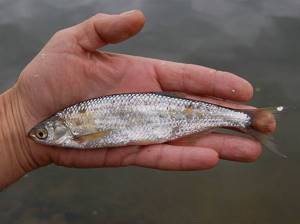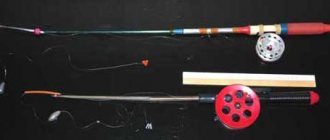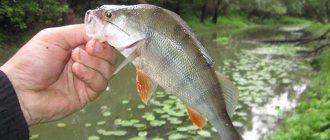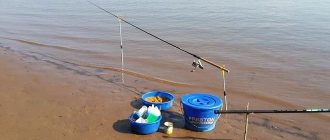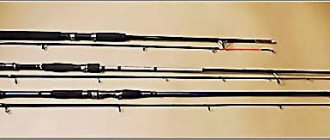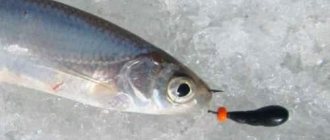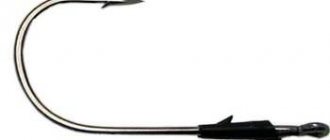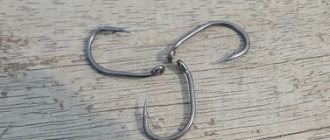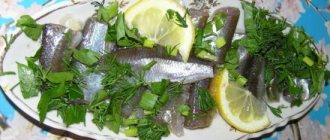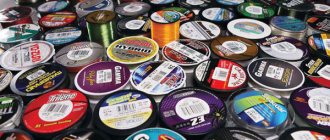Author of the article
Andrey Soprykin
Professional fisherman with 23 years of experience.
Articles written
85
Bleak is a small fish from the Carp family. It can be found in huge quantities on the surface of reservoirs with clean water and a sandy bottom. This fish is salted in various ways and sprats are made from it. It can also be used as live bait for larger predators. Despite the fact that bleak is found in large quantities in our rivers, lakes, ponds, and streams, it just won’t bite. Therefore, you need to know what to catch it with in order for your fishing to be productive.
Rice. 1. Despite its small size (up to 15 cm in length, weight 70-100 g), the bleak is a predator, albeit a conditional one. That is, it eats foods of both animal and plant origin.
We recommend watching a very useful video about catching bleak:
Features of catching bleak
Before you figure out what the bleak bites on, you need to understand the peculiarities of its behavior, only in this case the fishing will be successful. No need to fish in great depth. When fishing from a boat or pier, it is enough to lower the bait 1-2 m. When casting from the shore, the depth should be even less, about 0.7-1 m. The fish prefers to feed during daylight hours, but in too hot weather it may not respond to any bait.
Bleak is very greedy for food, so it grabs the bait almost immediately. After that, she pulls the float to the side. There is no point in waiting, because the catch may be missed; you need to hook it with lightning speed. The fish is not afraid of absolutely any noise and always stays closer to the shore. Therefore, you can safely come to the reservoir by car and even take your children fishing with you. This is great family time. Noisy kids will not affect the catch in any way.
Expert opinion
Valery Andreevich Sizov
Professional fisherman with 35 years of experience
Note! The best time to catch bleak is from May to October inclusive. In April and November the catch will be meager. From December to March inclusive, it is almost impossible to catch.
How to catch, bleak tackle
When fishing from the shore, they take long 5-7 meter rods. The best ones are bleak ones, as they are light and allow you to fish a large area of the reservoir. Specialized blanks allow you to fish comfortably, preventing your hand from getting tired after frequent casts.
If you fish from a boat, 2.5 - maximum 4 meters of blank length is enough. The equipment is the same as in summer and spring, we will not dwell on it. The site contains information, both in the “gear” section (see site menu), and separate articles on its elements.
How to equip? It is best to watch the video on equipment in this article, everything will be immediately clear and understandable.
The fishing technique is as follows:
- We throw a small ball of bait, cast it there, retrieve, if there is no attack, a slight twitch, retrieve again. We repeat several times.
- If there is no bite, we change the depth descent. Next in the same order: casting - wiring. At the first bites, we fish in the found horizon.
Feed constantly, volume - take a pinch, roll it into a ball, and after 1-2 casts it’s at the fishing point.
What does bleak eat in its natural environment?
When deciding what to catch a small fish with, you need to find out what bleak eats in its natural environment, and based on this, select effective bait and bait. The predator is practically omnivorous; it will not refuse even plant foods, but it prefers meat. For example, various midges, insects, eggs and even fry of other fish.
Expert opinion
Valery Andreevich Sizov
Professional fisherman with 35 years of experience
Interesting information! While fishing, many have noticed how a flock of bleak swims through a pond, then suddenly stops. Individuals lie on their sides and, wriggling their whole body, jump out of the water. This is how, in the natural environment, a predator catches insects that are circling in the air.
Rice. 2. A flock of bleaks went hunting for midges.
Where to catch bleak
Finding fish is not easy, especially on the river - you need to look around. In the fall, bleak can either constantly move or hang in the water column in one place for hours. In this case, only an active search will help.
In September, fish can be found in the river in relatively deep areas with weak and reverse currents, in coastal backwaters, and near steep yars. But the best area where large bleak can be found is the border where the circular pool exits into the current.
In reservoirs, bleak stays in clean, deep places, away from the coastal zone. In flowing lakes it stands on the channel current.
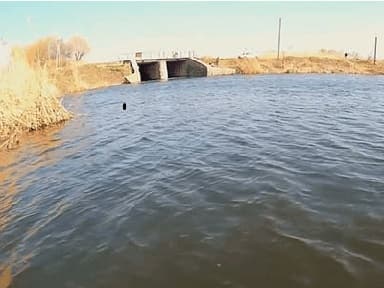
You can try to catch it about 2-3 meters from coastal surface vegetation (reeds, reeds) if there is a dump immediately behind it. You can read more about bleak places and sites in the article on finding fish.
Since it is inconvenient to catch it constantly chasing it around the reservoir, simple wet sand has proven itself to be a good way to attract it to the fishing zone. Throughout the fishing, it can be thrown from time to time to the floats, instead of bait or with it.
Thanks to its curiosity, the bleak will spin in the zone of falling sand or the cloudy spot created by it. Autumn catches are sometimes very good.
Bait for float rod
When choosing bait for a float rod, you need to take into account what bleak eats in its natural environment. Based on this, you can understand what the fish are biting on:
- maggots;
- bloodworm;
- various small worms;
- semolina;
- dough;
- crust of white bread;
- flies, midges.
When fishing in April-early May, it is almost impossible to get maggots, bloodworms, and flies on your own. Therefore, you have to buy bait, which is not always convenient. Of course, you can use dough, white bread or worms, but fishing with semolina gives the best results. It is recommended to make mash from it. It sits securely on the hook and can withstand several bites.
To make it easier to transport the chatter and apply it to the hook, it is best to fill the semolina into a large 5 cc syringe. This can be done in two ways:
- Remove the plunger and insert the syringe with the large hole into the semolina. Through the hole for the needle, pull it in with your mouth.
- Pull out the plunger and fill the semolina with a spoon or stick.

Rice. 3. Apply semolina to the hook using a syringe.
Expert opinion
Valery Andreevich Sizov
Professional fisherman with 35 years of experience
Note! When using a float rod, you don't have to think too much about how to catch fish. You just need to throw a hook into the pond and wait for a bite, then make a timely hook.
Tackle and fishing methods
To ensure year-round bleak fishing, you need to stock up on a variety of gear. Accordingly, fishing tactics and techniques change.
Float rod
The most popular fishing rod for bleak is the float rod. It is caught throughout the open water season, starting in April, when the spring sun has just warmed up the top layer of water. During the year, the equipment is slightly changed in accordance with fishing conditions.
A float for catching bleak is most often built on the basis of the lightest fly rod 3-4 meters long. It is equipped with a monofilament line 0.08-0.12 millimeters thick. Coarser tackle should be used if there is a chance of catching crucian carp, roach, bream or other larger fish in the bycatch. By the way, when catching our silver beauty, you need to be prepared for such consequences.
Advice! On the river, it is better to use a Bolognese fishing rod, which is more adapted to fishing conditions in the current.
A light float is placed on the fishing line, the carrying capacity of which usually does not exceed three grams. Here they follow the rule that weight depends on the strength of the current, so in a stagnant body of water only one gram is enough.

Sticky floats have a spindle-shaped shape and a long keel for better stabilization in the water flow.
The float is loaded with several pellets, and their position is changed depending on the temperature of the water and where the fish are located. In spring and autumn, when the bait is deep enough, the weights are moved lower to the undergroove so that the hook with bait reaches the desired horizon faster.
In the summer, in warm water, schools of fish stand below the surface of the water, so the pellets are distributed evenly from the feeder to the float so that the bait sinks as slowly as possible.
The smallest hooks are used; depending on the bait, they can be from 18 to 24 numbers according to the international classification. You can often notice that on the gear of athletes or simply experienced fishermen, the hooks do not have barbs.
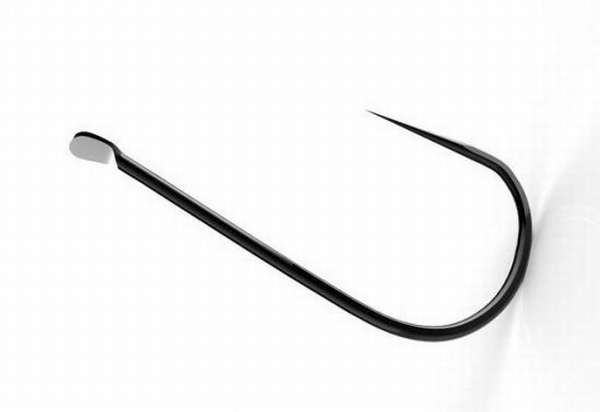
Barbless hooks allow for high-speed fishing and significantly save time on removing fish.
Fishing with a float rod begins with a test feeding of the place. Throw several small balls of bait into the water and watch the behavior of the fish. The bleak gathered for a treat will give itself away.
Now you need to spread the bait so as to mark the fishing spot with a diameter of about a meter. The bleak will be located at a feeding point, where it must be quickly caught.
Advice! You need to add bait regularly in small balls the size of plums. This must be done every time you remove the equipment from the water and at least once every two minutes.
Side nod
This tackle is also mounted on a lightweight form no more than four meters long. For this method of fishing, which involves constantly keeping the fishing rod in the angler’s hand, lightness is the most important requirement.
The rod is equipped with a nod designed to support the weight of a light sized jig and the thinnest fishing line of 0.08-0.10 millimeters.
A small jig in the form of a drop, oatmeal or ball is tied to the end of the fishing line. The shape of its bait is not so important, since the bleak is tempted by the bait or bait.

To fish at a great distance from the shore, they enter the water using waders or waders.
In terms of tactics, fishing with a side nod is practically no different from float fishing. The same search for fish with trial bait balls, the same retention of a school with constant additions of tasty balls.
The technique of moving the jig in the water should be smooth with an amplitude of 10-15 centimeters. At the initial and final stages, you must hold the bait for a couple of seconds. Often it is during pauses that the bite occurs.
Feeder and Donka
In cold water, when bleak moves closer to the wintering pits in the lower layers of the reservoir, it becomes advisable to use bottom gear, including a feeder, to catch it. Depending on the presence of a current and its strength, rods of different tests are used: from 40 grams for standing reservoirs to one hundred and above for rivers.
The feeders are equipped with spinning reels suitable for the weight of the form, 4000-6000 Shimano units. They are wound with a monofilament, 0.22-0.28 mm, or a braid, 0.14-0.16 mm, with a shock leader. The leashes are the thinnest, 0.08-0.10 millimeters.
The best rig for catching bleak is a “helicopter and two knots”. It is this feeder equipment that allows you to quickly change the fishing horizon, which is important when fishing for pelagic fish.
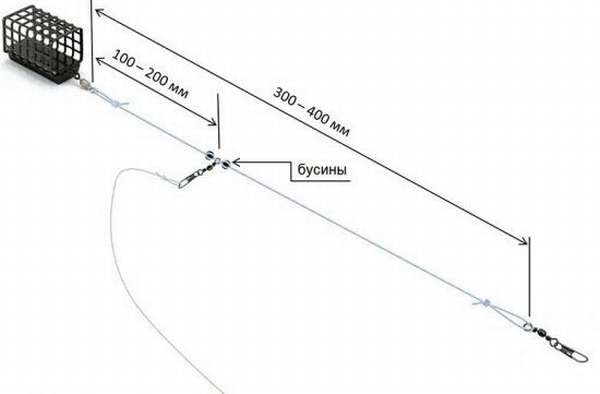
Changing the fishing horizon in a helicopter rig is done by moving the beads along the main fishing line. Preparing equipment for catching carp
Fishing tactics consist of searching for a point of local depression of a reservoir near the edge or on a plateau. To do this, use any of the methods familiar to the fisherman:
- echolocation,
- measured with a marker,
- jig tapping,
- repeated casting method.
After the point has been determined, start feeding is done.
During the fishing process, you need to constantly experiment in order to achieve a constant active bite. To do this you need to vary:
- fishing horizon,
- leash length,
- bait or attachment, its volume.
Spinning and fly fishing
In these sporting methods of fishing, gear and baits with the prefix micro or ultra are used for bleak. Ultralight sticks are chosen for spinning, and the following are used as bait:
- micro turntables,
- microoscillators,
- applied silicone,
- fly spinners.
Fly rods should also be of the lightest classes, 1-6, with appropriate lines, leaders and leaders.
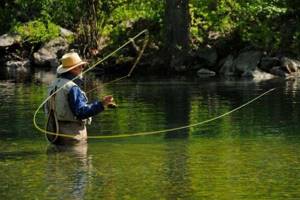
You can fly fish for bleak in any body of water where this fish is found.
The choice of bait for both fishing methods depends on the time of year. In warm water, surface decoys are used, in cold water, deep decoys are used.
Winter fishing
Bleak feeds all winter, but actively bites starting in February during the pre-spring thaw. At this time, the fish rises to the upper horizons of the water, almost reaching the lower boundary of the ice.
They catch it with two types of fishing rods:
- float,
- mormuscular
The choice of a specific model depends entirely on the personal preferences of the fisherman. Some people like to watch the movements of the float, others are interested in animating the jig.
Poplavchanka
A float fishing rod is built on a short fishing rod with legs and a device for storing fishing line: a reel or reel. In addition, it is also equipped with a short, 10-20 centimeters, whip, on which one or two passage rings or cambrics are located.
The winter float fishing rod is equipped with a thin sports fishing line with a diameter of 0.06 to 0.10 millimeters. A winter float of any design familiar to the fisherman is mounted on it and loaded so that the body is slightly submerged under water. This is necessary to prevent it from freezing into the crust of ice that forms in the hole.
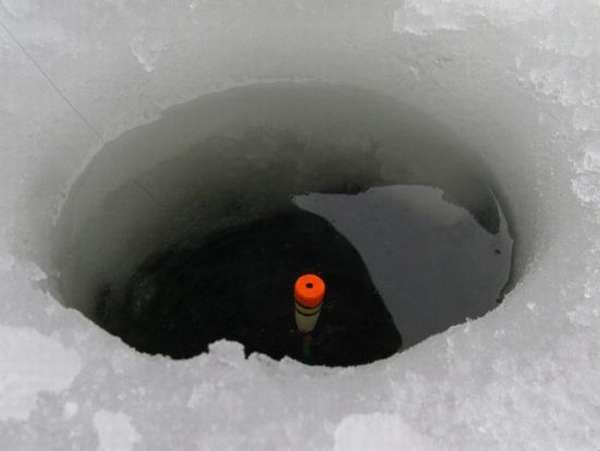
The upper part of the float is made wide and bright, because it is this part that is responsible for visualizing the bite.
Small hooks are tied below and above the sinker in such a way that they do not overlap during fishing. Using two elements provides the following additional capabilities:
- use of different nozzles,
- catching two fishing horizons.
Advice! Often in the same hole, but at different depths, there are flocks of different sizes. Therefore, it is better to fish with two hooks, placing them with a noticeable difference in height, and even better to use two fishing rods in adjacent holes.
The holes are fed directly from above without the use of feeders. It must have stirring components that perform two tasks at once. They provide a plume column of turbidity under the hole. It is on such a spot that flocks of bleak gather.
The second task of the muddy components is to darken the hole from daylight, which allows you not to scare away the fish gathered for bait.
Mormyshka
A fishing rod for fishing with a jig differs from a float in the presence of a nod, which is attached to the end of the whip. For sticking, this element of the equipment must be long and relatively soft to ensure smooth sweeping movements of the bait under water.
At the end of a fishing line 0.06-0.10 millimeters thick, a small jig in the form of a droplet, oatmeal, or pellet is tied. Above it, 10-30 centimeters, a small hook is attached to a short leash of 5-7 centimeters. The role of the additional element is described above, in the chapter on the float.

The jig and the nod must be matched to each other at home when installing the equipment.
Catching bleak in winter with a jig, from the point of view of feeding, is no different from that for float gear. The same compositions and the same technique for delivering the mixture to the well are used.
As for the fishing technique, after lowering the jig under the water, they begin to make smooth up and down movements with an amplitude of 10-15 centimeters. When playing with bait, it is necessary to take pauses of varying durations. On each specific hole, the technique may vary slightly, all this can be adjusted during the fishing process, depending on the frequency of bites.
Spinning bait
Nozzles for spinning rods are selected based on the time of year and the characteristics of the reservoir. Closer to winter and early April, it is recommended to use:
- nozzle jigs;
- burdock moth larvae;
- small bloodworm.
In open water the following show good performance:
- larvae of gadflies;
- caddisflies;
- flies;
- maggots;
- worms;
- dough with added flavors that attract fish.
Regardless of the type of reservoir and weather conditions, light and miniature fly spoons with a propeller have proven their effectiveness . You can try fishing with wobblers, but they must be no more than 1 cm.
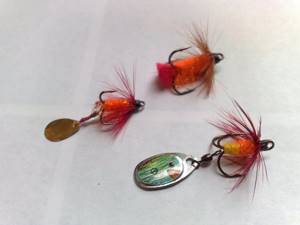
Rice. 4. What do fly baits look like for bleak.
If none of the above is available, you can use various silicone attachments. However, they should be small enough, no more than 1 cm. If the existing baits are not suitable, the silicone can be easily trimmed.
Fly fishing bait
This technique for catching bleak also shows high efficiency. The following can be used as artificial bait:
- dry and wet flies similar to insects;
- nymphs resembling worms or larvae;
- streamers similar to small crustaceans and leeches;
- homemade flies.
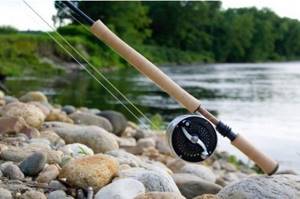
Rice. 5. What does fly fishing tackle look like?
Search for bleak
Bleak prefers to stay in the upper layers of water, feeding mainly on insects that have fallen into the water.
It can be found in shallow places with moderate currents, under overhanging trees, in thickets of water lilies and reeds. However, schools of these fish do not stand still; they constantly migrate across the reservoir in search of food. The movement of schools does not occur chaotically, but exclusively in the direction of the wind. They begin to catch bleak in early spring, 2-3 weeks after the ice melts.
During this period, it sticks to deep areas, sometimes coming to the shore to feed. You should look for it at the confluence of melt water streams - unique sources of food that carry insect larvae and grass seeds in their waters. It is best to use a small worm, maggot and bloodworms as bait. Vegetable baits in early spring arouse suspicion among this cautious fish. The best time to catch bleak is the end of May, when the first flight of insects from the bottom begins. In summer , on the contrary, bleak is best caught on bread, dough and steamed cereals, but insects remain its favorite food. From spring streams, schools move to shallow areas of the reservoir where there are trees and aquatic vegetation that protect small fish from predators. The summer bleak bite is the most confident. However, when weather conditions change, this fish immediately goes deeper and stops feeding.
As the water gets colder, the fish become less active, but continue to stay in the well-warmed shallows. In late autumn, when its state becomes close to torpor, a hungry bleak eats everything that swims by, but it bites best on a combined bait such as a “sandwich” of maggot and pearl barley, as well as on various insects.
In winter, this fish is caught with a winter fishing rod using the same bloodworm or a jig. Winter mooring sites for bleaks are coastal shallows with bottom vegetation.
Lure
Before catching bleak, you must first feed it. This will guarantee a good catch. The finished mixture can be purchased at a fishing store. However, experienced fishermen say that homemade fish is more effective. You will need:
- breadcrumbs (2 parts);
- flavoring (eg vanilla);
- ground sunflower seeds (1 part);
- milk powder (100 g);
- clay or sand from the reservoir in which bleak will be caught (1 part).
The breading and seeds should be ground very finely. Add clay or sand, milk powder, flavoring to this mixture, then fill everything with water. The result should be a thick and sticky paste. Twist small balls from it (about 5 cm in diameter) and throw them into the reservoir, first at the fishing spot, and then closer to the coast. After 10-15 minutes you can cast.
In conclusion, I would like to add that before you can choose an effective bait for bleak, sometimes you have to try several options. However, in most cases, the predator willingly takes any bait, especially if it is well fed. Therefore, there will be no difficulties with fishing.
Read where to go fishing on the weekend in the Moscow region here.
Autumn: time to catch large bleak

With the autumn cooling, roach, crucian carp and bream noticeably decreased their activity, and bleak, on the contrary, clearly became more active. The bleak is now lively, large and fat.
I believe that you should not limit yourself to primitive fishing for this most interesting fish during select periods of the spring-summer season, when bleak becomes the prey of even a novice angler.
Bleak can be caught all year round. But very few can boast of having caught it in summer, late autumn and winter.
After the June spawning, bleak does not lose interest in food, but becomes less accessible to the fisherman. Large bleak switches to feeding on numerous small insects, which fly in abundance in the air and periodically fall to the surface of the reservoir.
Throughout July and almost all of August, bleak feeds on insects. The fish becomes well-fed, cautious and very selective in relation to the baits offered to it. And there are few hunters who want to chase every fish, using as bait the next mosquito that lands on their hand.
With the autumn cooling of the water, large bleak rarely approaches the very shore and specialized fishing gear for it requires slightly different gear, unlike in the spring.
A lightweight “poly” rod up to 7 m long, capable of casting equipment weighing 0.5 g.
I’ll tell you that in rods for catching bleak and roach in hot summer and cold autumn, what is valued above all is the ability to accurately cast light equipment.
Don’t forget a simple rule: the closer autumn is and the colder the water, the deeper the large bleak is. The equipment should be as simple as possible, so that you can quickly change the descent from 30 cm to 2.5 m.
This is due to the fact that the bleak is able to change the horizon of its location within a few seconds.
The spring, nutritious bait will have to be replaced with another, faster-acting and less nutritious one. In the composition of the bait, it is necessary to reduce the content of crackers to 10% due to an equivalent increase in the content of bran. And the question of choosing an activator is very important.
In fishing practice, an activator is any additive that helps increase the effectiveness of bait and leads to an increase in fish activity.
Most of the “secret” bite activators are all kinds of extracts, essences and extracts from products of natural origin. Artificial (cheaper) flavors that imitate the amino acid composition of plants, fruits and even plant pollen are good for that short period of time of the year when the simulated plant is flowering, pollinating or shedding fruits.
The selection of an activator is pure alchemy, but, most likely, for spring fishing it will be one activator, for summer – another, and for autumn – a third, and this is still very arbitrary. The activator is added to the bait only after water from the reservoir has been added to the mixture of crackers, oatmeal, cake, sugar and salt prepared the day before, that is, immediately before fishing.
So, for example, having noticed raspberries on bushes growing near a pond, I always pick up some berries and eat them with pleasure. And after the feeling of original hunger leaves not only my stomach, but also my consciousness, I send another handful of fruits to the bait. And there has not yet been a single case where the described actions brought zero effect.
With experience, I began to act more simply.
Having arrived at the fishing site and seeing, for example, a completely faded rosehip bush, I take out the appropriate attractant-flavor and add it to the bait.
What is this component and how can it be replaced?
No secrets! Regular apple, pear, currant, raspberry, potato or strawberry juice.
Cocoa powder, vanilla sugar, garlic and artificial honey are good as a general, non-seasonal supplement. Moreover, in the warm season it is good to use artificial honey instead of water, mixing bait with it. It’s a good idea to add dry kvass or dry yeast to the bait, but directly on the pond.
Rapid fermentation in warm water makes the bait loose and light, and the bleak itself likes the smell of yeast. Warm water when fishing for bleak is water with a temperature above 16-18 degrees.
Despite the fact that the main bait when catching bleak is maggot, adding small food bloodworms to the bait can lead to fantastic results. Approximately 200 g of small bloodworms should be added per 2 kg of prepared bait. Good bait with the right feeding technique can collect and concentrate bleak, and competent and balanced tackle will help you catch it efficiently and quickly.
But then summer ends, insects, having completed their natural life cycle, go through the stage of reproduction and die off, plants drop their ripe fruits, and bleak begins to prepare for the upcoming hungry winter.
Let me clarify right away that a hungry winter for bleak occurs in water bodies with low flow and poor food. In flowing water bodies rich in caddis flies and amphipods, bleak feeds on occasion throughout the winter almost without interruption.
But how can you prepare for winter if you don’t have the usual “top” summer food?
And the same as in the spring, when there is no usual summer food. The bleak is looking for food of animal origin.
She does not refuse any natural food, but does not rush to feed. Almost the only bait that can activate bleak in late autumn, that is, capable of arousing its interest in active feeding, is bloodworms. And not small ones, but rather large “attached” bloodworms.
It is very effective to throw 10-30 bloodworms at the fishing point, but first you need to squeeze the larvae with your fingers so that they fall to the bottom more slowly and quickly release components that irritate the fish.
If the place and time of fishing is chosen correctly, then one hundred grams of baited, large bloodworms is enough to activate a large (several hundred heads) flock of bleak, which has taken its place on the upper, deep edge of the wintering pit.
If this succeeds, then you will be convinced that it is advisable to catch large bleak not in the spring, when it is hungry and stupid, but when it stands at a depth of 2.5-4 m and waits not only for the ice to form, but also for your attachment on a microscopic hook and the finest equipment.
|
| This is a standard size for fall. Photo: Andrey Yanshevsky. |
The technique for catching autumn bleak is fundamentally different from the technique for catching in the spring and summer. This is due to the fact that cold water does not encourage unnecessary body movements. The technique for catching autumn bleak is similar to the technique for catching roach.
Casting the lightest rig with one bloodworm on the hook. Waiting for the moment when the float takes its normal position. Pause for 5-10 seconds.
Very slow movement of the equipment to the side. Throw in a small dose of bloodworms. Control cutting. Changing the nozzle. Casting equipment. Observation of the fall of equipment with a nozzle. Pause.
And so on until the first bite. You just need to remember that before each subsequent cast after an “empty” retrieve, you should change the descent by 5-10 cm in any direction.
Having empirically found the depth at which the bleak is currently standing, you need to fix it in memory. In autumn, bleak rarely rises to the surface of the water and generally rarely moves in its thickness for several hours. Therefore, the depth found will be the fishing depth.
Further - easier. Having caught the first fish, you just need to strictly repeat your actions and try to prevent the next fish from leaving
If at least once you manage to catch a large autumn fat, cautious bleak, then I am sure that you will understand that this is a very difficult and interesting fish for the hunter.
The legend about the simplicity and accessibility of catching bleak and, as a consequence, the disdain of most anglers for this fish, will disappear in your eyes after you manage to “catch” it in the fall.
Autumn bleak is not only lively, but also very tasty. Especially deep fried.
Andrey Yanshevsky September 11, 2021 at 05:10
